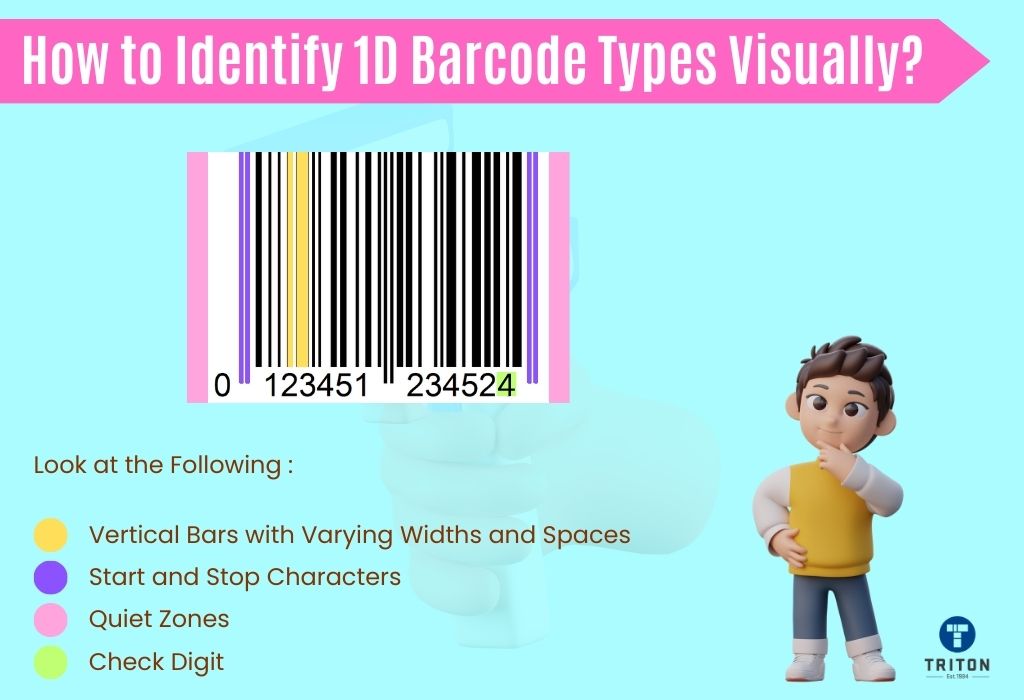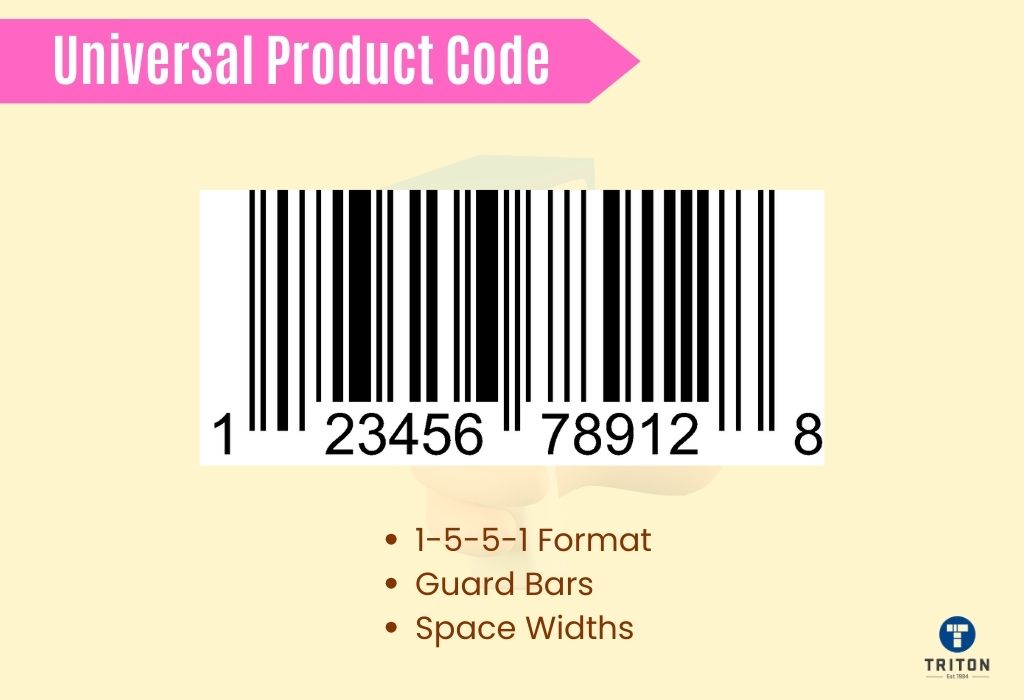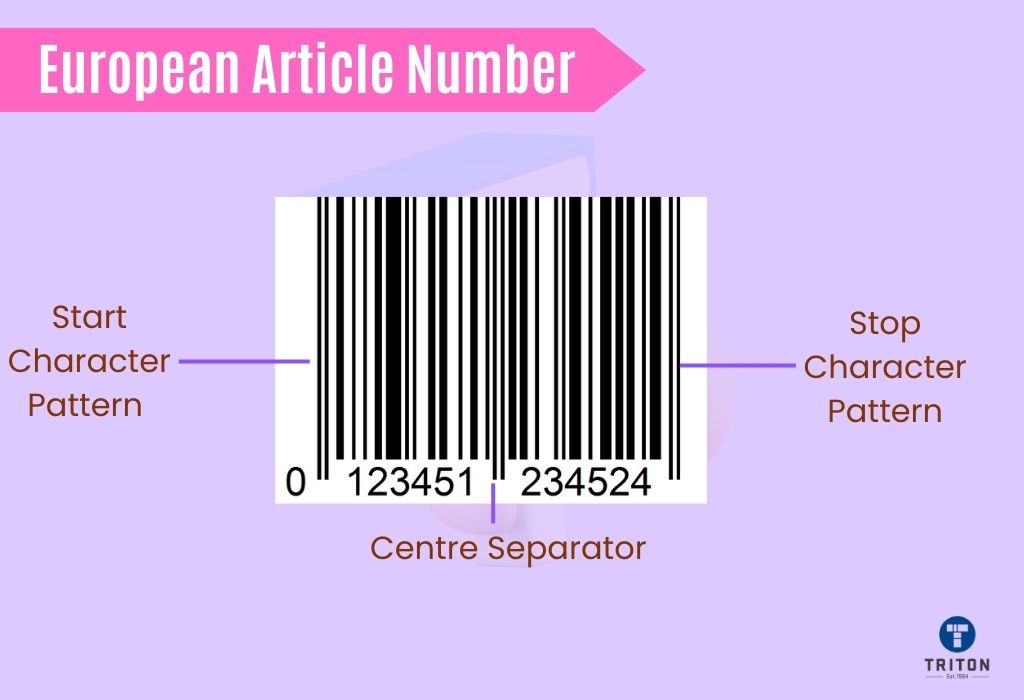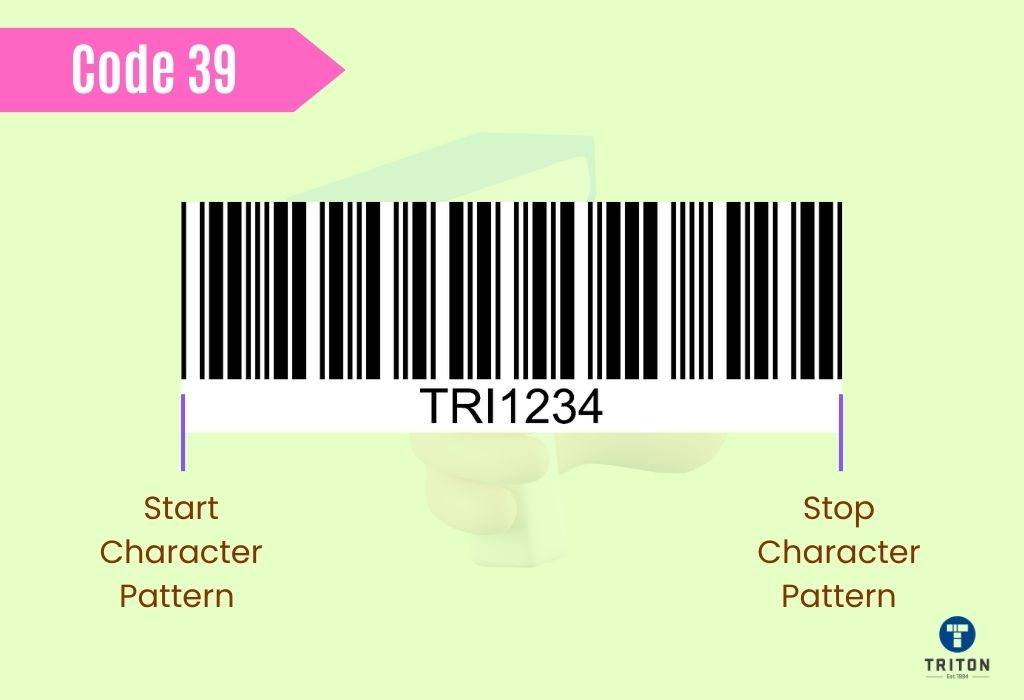
Barcode identification plays a key role in enabling efficient barcoding operations. One way to identify barcodes is through visual examination.
Different barcodes have distinct patterns and features that allow them to be identified visually. By visually recognising the barcode type, one can determine the data type encoded in the code, its usage and the most suitable barcode readers to use.
In this article, we will provide you with an overview of the distinct features associated with the most popular barcode types that can be identified with the naked eye. We will start by covering 1D barcodes, followed by 2D barcode types. But first, here is a quick overview of what a barcode is.
Barcodes are machine-readable symbols that store data about a product, item or object. This data can be encoded in the form of numbers, letters and special characters. Barcodes are composed of patterns such as lines, dots, rectangles and other shapes with varying widths arranged in a specific sequence.
Barcodes are of two types, namely, 1D and 2D barcodes. 1D barcodes encode data horizontally, from left to right, in a single line, whereas 2D barcodes contain information both horizontally and vertically on a two-dimensional plane.
Check out our detailed guide, Barcode 101, to learn more about barcoding technology. The guide covers topics such as the working of barcodes, the representation of data in a barcode, anatomy, drawbacks and more.

One-dimensional barcodes, also known as linear barcodes, are the traditional types of barcodes.
1D barcodes typically consist of a series of vertical lines with varying widths and spacing between them. They have an additional start and stop character at either end of the code, representing the beginning and end of the code.
1D barcodes have quiet zones, which are empty white areas on all sides of the barcode symbology. The widths of these zones vary between different 1D barcode types. 1D barcodes also have a single check digit, used to verify the accuracy of data encoded in the barcode.
By identifying vertical lines, start/ stop characters, quiet zones and check digit, one can easily visually identify the type of barcode. Here is the list of 1D barcodes that can be identified visually.

The UPC stands for “Universal Product Code” and is the most common type of 1D barcode. It consists of 12 numeric digits with a 10-digit GS1 company prefix followed by one check digit and a product number.
UPCs are mostly used for retail products, allowing them to be identified upon purchase.
Here’s how you can visually identify a UPC barcode.
There are two types of UPCs – UPC-A and UPC-E.
UPC-A commonly called UPC is the standard version of the UPC code. It can be identified by following the above process.
UPC-E, also called 0-Suppressed UPC, is a shortened version of the UPC-A barcode designed for items with limited packaging space. UPC-E encodes a total of eight digits – six numeric message digits, a number system digit, and a check digit. Therefore, if a UPC barcode has only eight digits, it is a UPC-E barcode.

The EAN stands for “European Article Number.” These barcodes are similar to UPCs in appearance and function, with the only difference in geographical application.
EAN barcodes can store 2 to 13 numeric digits based on the type used.
Here are the visual cues to identify an EAN barcode.
There are two types of EAN codes EAN-13 and EAN-8.
EAN-13 is the standard version of the EAN barcode. It encodes 12 numeric digits and a check digit. It can be identified by following the above process.
EAN-8 is the shortened version of the EAN-13 barcode designed for items with limited packaging space. It encodes seven numeric digits and a check digit. Hence, if an EAN barcode has only eight digits, it is an EAN-8 barcode.

Code 39 barcodes, also known as Alpha39, Code 3/9, Type 39, or Code 3 of 9, is a variable length, discrete symbology used to store alphanumeric data. It is the first alphanumeric barcode format widely used and found in non-retail sectors such as aviation, medical and military.
Code 39 is capable of encoding 43 characters and supports the following data types.
Code 39 can be visually identified by.

Code 128 is a high-density linear barcode symbology. It is a variable-length barcode, which means there is no limit to the number of characters that can be encoded.
Code 128 can encode all 128 ASCII characters, including lower case and upper case English letters from A to Z, numbers from 0-9, and some special characters. It is widely used in the healthcare and logistics industry.
Here’s how you can visually identify a Code 128 barcode.
Check out our Code 39 VS Code 128 comparison guide.

GS1-128, previously known as UCC/EAN-128, is a subset of the Code 128 barcode symbology designed to encode GS1 System data. The GS1 System is an international standard that assigns unique identifiers to products and services, enabling better traceability across the supply chain.
A GS1-128 barcode can encode 48 alphanumeric characters. They feature an Application Identifier (AI), a two- or three-digit code that indicates the type of data encoded within the symbol.
Here’s how you can visually identify a GS1-128 barcode.

Code 49 is a continuous, variable-length stacked barcode symbology. This barcode uses a pattern of discrete cells and modules to stack multiple rows of information on top of each other into a single symbol.
A Code 49 barcode can encode up to 49 characters per row. It supports 128 full ASCII characters, including lower case and upper case English letters from A to Z, numbers from 0-9, and some special characters. Code 49 is widely used in the defence sector, logistics and pharmaceutical industries.
Pay attention to the following cues to distinguish a Code 49 barcode.

Code 93 is a continuous, variable-length barcode symbology. It can encode.
Code 93 is widely used in industrial settings and by Canada Post to encode supplementary delivery information.
Here’s how you can visually identify a Code 93 barcode.

Interleaved 2 of 5, also called ITF-14, I2/5, I/L 2 of 5, 2/5 Interleaved, and ANSI/AIM ITF-5 is a continuous, numeric-only barcode. It is a variable-length barcode, which means there is no limit to the number of characters that can be encoded.
Interleaved 2 of 5 barcode encoding works by interleaving pairs of digits to form a single symbol. As a result, it can only encode an even number of digits. In the case of odd numbers, the system adds a zero to the beginning of the code.
Interleaved 2 of 5 is widely used for product identification and tracking in the distribution, shipping and warehouse industries.
To identify Interleaved 2 of 5 barcodes visually, pay attention to the following cues:
GS1 DataBar, previously known as Reduced Space Symbology (RSS), is a versatile barcoding system designed to encode GS1 System data. Compared to other linear barcodes, it offers a smaller size and higher data density.
GS1 DataBar is a family of 1D barcodes and has various types, including.

GS1 DataBar Omnidirectional is a 14-digit numeric barcode symbol. It encodes Global Trade Item Numbers (GTINs) and Global Coupon Numbers (GCNs). GS1 DataBar Omnidirectional can be read omnidirectionally and is used for retail point-of-sale applications.
To identify a GS1 DataBar Omnidirectional code, you can follow these key points.

GS1 DataBar Stacked Omnidirectional is a type of stacked GS1 DataBar barcode. It has the same features as GS1 DataBar Omnidirectional but is a stacked version. It also has the same 14-digit numeric-only capability and can be read omnidirectionally. It is used for retail point-of-sale applications, just like its un-stacked counterpart.
To identify a GS1 DataBar Stacked Omnidirectional barcode, you can look out for the following features:

GS1 DataBar Expanded is used to encode supplementary data in addition to GTINs and GCNs. These barcodes can encode numeric digits, alphanumeric characters and special characters such as exclamation points, question marks, colons, hyphens, semi-colons, asterisks, etc.
GS1 DataBar Expanded is a variable-length symbol capable of encoding up to 74 numeric or 41 alphanumeric characters.
You can follow these key points to identify a GS1 DataBar Expanded code.

GS1 DataBar Expanded Stacked barcode is a stacked version of the GS1 Expanded barcode symbology. It has the same data-encoding capabilities as GS1 DataBar Expanded but is arranged in a stacked form.
To identify a GS1 DataBar Expanded Stacked barcode, pay attention to the following aspects:

GS1 DataBar Limited is a compact barcode symbology with a fixed length, specifically designed for applications where space is at a premium. It has a capacity of 14 numeric digits and can encode GTINs that start with either “0” or “1.” GS1 DataBar Limited is primarily used in the healthcare industry.
To identify a GS1 DataBar Limited barcode, follow these points.

GS1 DataBar Stacked is similar to GS1 DataBar Omnidirectional but has a reduced height of 13 modules or less, preventing it from being omnidirectional. GS1 DataBar Stacked encodes 14-digit numeric digits and is used to store additional data.
To identify a GS1 DataBar Stacked barcode, you can follow these key points.

GS1 DataBar Truncated barcode is a numeric-only barcode symbology with a capacity of 14 digits. It encodes four types of Global Trade Item Numbers (GTINs): GTIN-8, GTIN-12, GTIN-13, and GTIN-14.
To identify a GS1 DataBar Truncated barcode, you can look out for the following features:

MSI Plessey barcode, often referred to simply as MSI, is a modified version of Plessey codes. It is a variable-length numeric-only barcode symbology primarily used in warehouse operations, libraries, and inventory control systems.
To visually identify an MSI Plessey barcode, look for the following elements.

The Telepen barcode is a continuous, variable-length barcode symbology primarily used in universities and other academic libraries in the United Kingdom. This barcode can encode all lower full ASCII character sets.
To identify a Telepen barcode, pay attention to the following details:
Telepen barcode has a variant known as the Telepen Numeric barcode, capable of encoding only numeric digits from 0 to 9.
The difference between the regular and numeric is that the numeric version can encode double-density numerical values, meaning that it can store twice as many numerical characters in the same space. This leads to more information being stored with less space used.
To identify a Telepen Numeric barcode, look at the encoded data type. If the barcode holds numeric data only, then you are likely looking at a Telepen Numeric barcode.

POSTNET, short for Postal Numeric Encoding Technique, is a fixed-length barcode symbology used by the United States Postal Service to assist in directing mail. It is capable of encoding numeric digits (0-9). POSTNET is a fixed-length barcode symbology representing five, nine or eleven digits.
To recognise a POSTNET code visually, follow these steps.
The POSTNET barcode can be in any of three ZIP formats: 5-digit ZIP code, 9-digit ZIP+4 code, or 11-digit Delivery Point Code.
5-Digit POSTNET barcodes encode the 5-digit ZIP Code. If a POSTNET barcode contains six digits (including the check digit) and has 32 bars, it is a 5-digit POSTNET barcode.
ZIP+4 POSTNET barcodes contain a 5-digit ZIP code plus an additional 4-digit code. If a POSTNET barcode contains ten digits (including the check digit) and has 52 bars, it is a ZIP+4 POSTNET barcode.
Delivery Point POSTNET barcodes contain the 11-digit Delivery Point Code. If a POSTNET barcode contains twelve digits (including the check digit) and has 62 bars, it is a Delivery Point POSTNET barcode.

Intelligent Mail Barcode, also known as the OneCode, is a type of postal barcode used by the United States Postal Service (USPS) for sorting and tracking letters and packages. It is a numeric-only barcode and can encode 20 to 31 numeric digits.
Here’s how you can visually identify an Intelligent Mail barcode.

Two-dimensional (2D) barcodes, also known as matrix codes, are symbols that encode data in both horizontal and vertical directions. These barcodes use graphics or patterns like squares, dots, hexagons and other shapes to store data.
Here are a few things to look for when identifying 2D barcodes:
Here is the list of 2D barcodes that can be identified visually.

QR code, short for Quick Response code, is a versatile 2D barcode that can store numeric, alphanumeric, byte/binary data and Kanji characters. It has the capacity to encode 2953 bytes of data, 4296 alphanumeric characters, 7089 numeric characters, or 1817 Kanji characters.
QR codes are used for a wide range of applications, from sharing information to payment processing.
Here’s how you can visually identify a QR code.

Data Matrix is a high-density barcode composed of black and white squares arranged in a matrix pattern. It is capable of encoding all 256 ASCII characters, ISO characters, and EBCDIC characters and can hold 2335 alphanumeric characters, 3,116 numerical characters, or 1556 bytes of information. Data Matrix codes find extensive use in the aviation, electronic, logistics, and automotive industries.
To identify a DataMatrix code, pay attention to the following details:

Aztec codes are matrix barcodes created with black and white modules. They have a distinctive pattern in the centre that resembles the square, multi-stepped Aztec pyramids. Aztec codes are often smaller in size compared to other 2D barcode symbologies.
Aztec codes are capable of encoding alphanumeric characters and binary data. They can hold 3,832 numerical digits, 3,067 alphabetic characters or 1,914 bytes of data. Aztec codes are widely used in the transportation industry for ticketing and tracking.
Here’s how you can visually identify an Aztec code.

Codablock is a stacked barcode symbology that is created by stacking rows of both Code 39 barcodes and Code 128 barcodes. Codablock is a family of barcodes which includes.
Codablock A is the first Codablock barcode variant developed between 1989 and 1995. It is made by stacking multiple Code 39 barcodes. Codablock A can encode upper-case letters (A–Z), numeric digits (0–9) and special characters. It has a data capacity of 1,340 characters distributed across 2 to 22 lines, each with 1 to 61 characters.
Codablock F is the current version built upon the foundation of the Code 128 barcode symbology. It can encode a full 256 ASCII character set. Codablock F has a data capacity of 2,725 characters distributed across 2 to 44 lines, each with 4 to 62 characters.
Codablock 256 is an internal barcoding standard developed by ICS Identcode-Systeme GmbH. It is made by stacking multiple codes 128 barcodes. Codablock 256 can encode all 256 symbols of the ASCII character set, including the FNC4 character. It has a maximum data capacity of 2,725 characters.
Here are the visual cues to identify a Codablock barcode.

PDF417, short for Portable Data File 417, is a 2D stacked barcode symbology that uses a pattern of bars or spaces of varying widths and heights to represent coded data. PDF417 codes are capable of encoding all 256 ASCII characters and 8-bit binary data. It can store up to 1850 alphanumeric characters, 2710 numeric digits or 1108 bytes of data in one symbol.
PDF417 codes are used for a range of applications such as banking, healthcare, transport ticketing and document tracking.
To identify a PDF417 code, here’s what to look for:

MaxiCode, also called “Bird’s Eye,” “Target,” “Dense code,” or “UPS code,” is a type of postal and shipping barcode composed of hexagonal modules or offset rows arranged in an array with a finder pattern at the centre. This barcode is developed and patented by United Parcel Service (UPS) and is widely used for tracking and organising package deliveries.
MaxiCode can encode all 256 ASCII characters and has the capacity to hold up to 93 alphanumeric characters or 138 numeric characters.
Here is what you should look for when identifying a Maxicode:

MicroPDF417 is a subset of the PDF417 barcode and is similar to PDF417 in structure. The barcode supports all 256 printable ASCII characters as well as 8-bit binary data and can store up to 250 alphanumeric characters, 366 numeric digits and 50 bytes of data.
MicroPDF417 is utilised across multiple industries, including logistics, warehousing, government, and inventory management.
To visually recognise a Micro PDF417 barcode, consider the following aspects.

JAB Code, short for Just Another Barcode, is a coloured 2D barcode symbology composed of colourful square modules arranged in square or rectangular grids. This barcode can encode numeric digits, uppercase and lowercase letters, punctuation marks, mixed characters, alphanumeric data, and binary data. JAB code finds use in industrial product identification and the pharmaceutical industry.
Identifying a JAB code is relatively straightforward, thanks to its distinct features and colours.

Code 1 is the first 2-D barcode symbology available in the public domain. It supports all 256 ASCII characters, function characters, and 8-bit binary data. It finds applications in the healthcare and recycling industries.
To identify a Code 1 barcode, here’s what to look for:
Barcode identification is essential to many different industries, including retail, logistics, healthcare, and manufacturing. By offering a standardised method to manage data, barcodes boost efficiency and minimise errors.
Let’s take a look at some practical applications of barcode identification.
Barcode identification plays a pivotal role in enhancing operational efficiency across many sectors. Recognising different barcode types enables staff to use the correct barcode reader and manage data with increased speed and precision, significantly minimising the margin for error.
As various industries continue to digitise and automate, the knowledge and understanding of barcode symbologies remain a crucial skill set, contributing to the seamless functioning of modern day-to-day operations.
We hope this article has provided some useful insight into how to identify barcode types visually.
Thanks for reading!
Melbourne
Brisbane
Phone 1300 558 438
Live Chat – Widget below
Melbourne
Brisbane
Phone 1300 558 438
Live Chat – Widget below